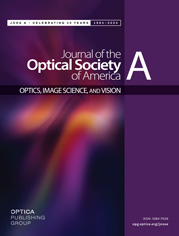Joint Feature Issue of Applied Optics and JOSA A
Digital Holography and Three-Dimensional Imaging 2022
Submission Opens:1 September 2022
Submission Deadline: 15 October 2022
Applied Optics and JOSA A welcome submissions to a feature issue associated with the "Digital Holography and Three-Dimensional Imaging 2022" topical meeting, held 1-4 August 2022 in Cambridge, UK. Whereas meeting participants are particularly encouraged to submit their work, the feature issue is open to all contributions in related areas.
This feature will highlight current research in digital holography and three-dimensional imaging including interferometry, phase microscopy, phase retrieval, novel holographic processes, 3D and novel holographic displays, integral imaging, computer generated holograms, compressive holography, full-field tomography, specific image and signal processing, and holography with various light sources including coherent to incoherent and X-ray to terahertz waves. Techniques of digital holography and of 3D imaging have numerous applications. The included articles will present state-of-the-art technological developments that are currently underway and stimulate further novel applications of digital holography and 3D imaging in biomedicine, biophotonics, nanomaterials, nanophotonics, deep learning, environmental sensing, and scientific and industrial metrologies.
Topics of interest include but are not limited to:
- Advances in digital holographic techniques
- 3D imaging and display systems
- Computer generated holograms
- Quantitative phase imaging
- Lab on Chip based on holographic microscopy
- Transport of intensity
- Compressive holography
- 2D & 3D image processing for digital holography & feature recognition
- Deep learning and neural networks in digital holography and applications
- Digital holographic microscopy
- Digital holographic tomography
- Digital holographic optical processing
- Metrology and profilometry
- Holographic lithography
- Digital holography for inspection of scattering media
- Wavefront shaping and manipulation
- Polarization holography
- Gated digital holography (time and coherence gating)
- Digital holography in LIDAR and related remote sensing techniques
- Incoherent holography
- Terahertz generation/modulation and its application to digital holography
- Biomedical/clinical/medical applications
- Environmental sensing
- Dynamic holography and novel recording materials
- Digital holography in nonlinear optical systems
- Emerging applications of digital holography
- 2D & 3D holographic display
- Holographic optical elements and their novel applications
Authors may choose between Applied Optics and JOSA A when submitting to the joint feature issue, but should recognize the differences between them and select the appropriate journal. The guest editors may recommend transferring a manuscript to the other journal as needed. For Applied Optics, submissions will emphasize the practical applications of science and technology. All other topics will be better suited for JOSA A. Papers will appear in their respective journals. Additionally, a combined table of contents of papers from both journals will appear once all papers are published.
All submissions need to present original, previously unpublished work and will be subject to the normal standards and peer review processes of the journals. The standard Applied Optics and JOSA A Publication Charges will apply to all published articles. To be eligible for publication, an expanded conference paper needs to add value to the original conference proceedings and the conference paper number must be included in the cover letter at submission. Please see Optica's guidelines on expanded conference papers for details.
Please prepare manuscripts according to the author instructions for submission to Applied Optics or JOSA A and submit through the Prism submission system, specifying from the drop-down menu that the manuscript is for the feature issue on Digital Holography and 3D Imaging.
Feature Editors
Daping Chu, University of Cambridge, United Kingdom [lead editor]
Jae-Hyeung Park, Inha University, Republic of Korea
Chau-Jern Cheng, National Taiwan Normal University, Taiwan
Pietro Ferraro, Consiglio Nazionale delle Ricerche, Italy
Partha Banerjee, University of Dayton, USA
John Sheridan, University College, Dublin, Ireland
Elena Stoykova, Bulgarian Academy of Sciences, Bulgaria

